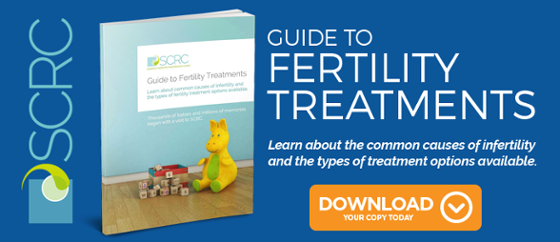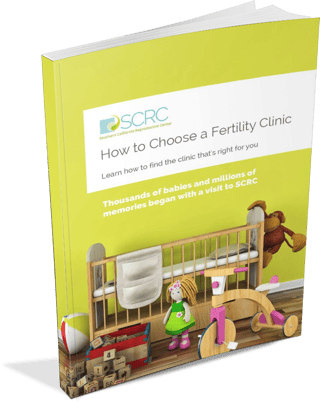
For many fertility patients, frozen embryos provide a backup plan and the opportunity to further build their families after a successful IVF cycle. After the fertility medications and ovarian stimulation, after the egg retrieval process, and after fertilization in the lab, a patient undergoing IVF may learn that they have more viable embryos than they need to transfer in one cycle. In most cases, your doctor will select one (or maybe two) high quality embryos for a fresh embryo transfer, in order to reduce the chances of a risky multiple pregnancy. The remainder of the embryos can be frozen and stored for later use.
In some situations, all the embryos from a cycle may be frozen so that the woman’s body can recover from the demanding IVF process before undergoing a frozen embryo transfer (FET) in a month or so. Sometimes, if fresh embryo transfers have failed in the past, FET can improve the chances of implantation, especially when used in conjunction with advanced testing such as Endometrial Receptivity Analysis to identify a woman’s optimal implantation window.
There are pros and cons to both fresh and frozen embryo transfer: you can read more about the differences in this comprehensive article. Whatever your reasons for considering FET, the first question you are likely to have is whether frozen embryos offer good success rates.
What are the factors that affect frozen embryo success rates?
When the first child was born from a frozen embryo transfer nearly 30 years ago, this was a difficult question to answer. Until fairly recently, FET success rates were inconsistent. There were two main reasons for this:
- Embryo quality: Today’s advanced fertility labs, techniques, and technology now make it possible to develop embryos in the laboratory until they reach the blastocyst stage at around five days. Five or six-day transfers have a much better chance of resulting in pregnancy, because embryos which survive to blastocyst stage are generally much stronger and healthier. This means that doctors can now transfer a single blastocyst with a good chance of success. Years ago, it was a struggle to keep fresh embryos alive and healthy in the lab for more than 3 days. As a result, it was common to transfer multiple embryos at a time, which usually meant that only the lowest-quality embryos were left over. These poor quality 3-day-old embryos had a much lower likelihood of surviving cryopreservation and later thawing. Even if they made it through, their chances of implantation were lower. Today, it is not uncommon to have 3 or more high-quality blastocysts leftover from a single IVF cycle, ready to freeze.
- Freezing techniques: Freezing embryos using cryopreservation used to be a somewhat risky procedure, where the chances of an embryo surviving both the freezing and thawing process was unpredictable. This was because the freezing method used was comparatively slow and the embryo’s delicate cells could be easily damaged by developing ice crystals. About a decade ago, a new, advanced freezing method was developed, called vitrification. Vitrification is a “flash freezing” process where the embryos are instantly cooled to freezing in seconds. Special advanced media is also used to help protect the cells, using substances known as cryoprotectants, which discourage ice crystals and allow the embryo’s cells to freeze smoothly. With these developments, frozen embryos now have much higher survival rates when thawed (over 95%), and much higher pregnancy rates, too.
What’s the latest research on frozen embryo success rates?
Recent studies have provided a great reason for hope when it comes to frozen embryo transfers. Consensus is that in most cases, FET success rates are at least as high as fresh embryo transfer success rates. For some women, FET success rates can actually be much higher than fresh embryo transfers. A study published earlier this year by researchers at Stanford University found that in women over 35 with high progesterone levels, frozen embryo transfers were 73% more likely to result in an ongoing pregnancy than a fresh transfer. Evidence is building in favor of FET for specific patient populations, with very exciting implications for how we make decisions about embryo transfers.
As always, we must keep in mind that each patient is unique, with countless individual factors which can contribute to her likelihood of getting pregnant from each embryo transfer, fresh or frozen. If you’re wondering whether FET could be the right decision for you, bring it up with your fertility treatment team. Whether you are considering a “freeze all” cycle or just want to know about preserving leftover embryos from a fresh cycle, your doctor can help you make a plan with the best chance of success for your particular situation.
Embryo freezing with SCRC has many potential benefits. Using the very latest technology and techniques performed by our board-certified embryologists and expert lab technicians, embryos are instantly flash-frozen and can be safely stored for up to a decade with no loss in quality. All frozen embryos are stored on site in our state-of-the-art ART lab, so they never have to leave the premises. Having frozen embryos in storage means that when you’re ready, you can skip the arduous first half of the IVF process and go straight to the embryo transfer procedure. When you’ve been through so much in your quest to have a baby, having this option available for the next time around is priceless.
Share this on social media:




